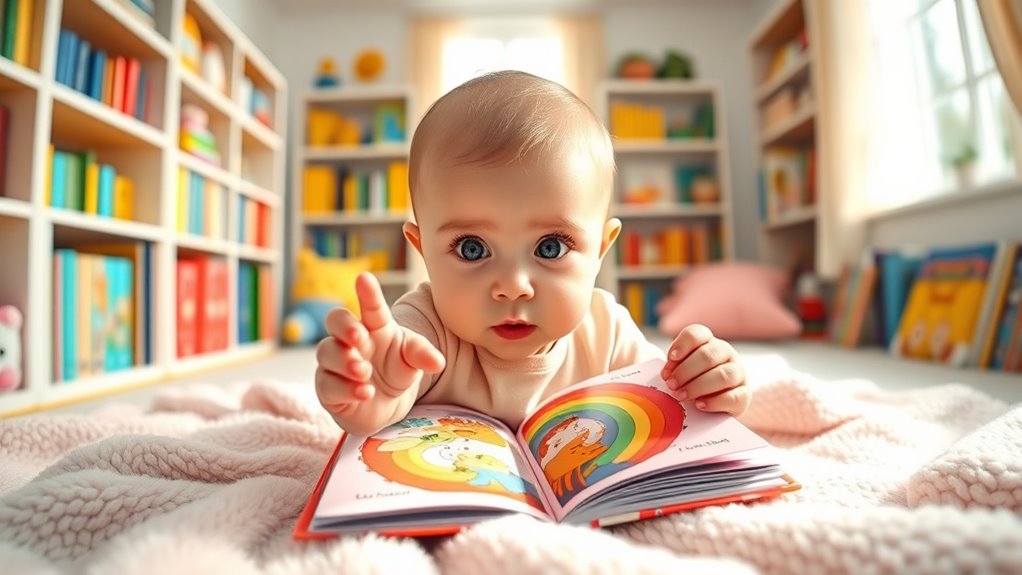Creating your baby’s first library involves understanding key milestones like recognizing early communication cues such as eye contact, gestures, and sounds. Incorporate simple picture books, repetitive stories, and engaging activities that develop their visual and auditory skills. Celebrate small achievements and respond to their signals to foster a love of learning. Keep exploring these tips, and you’ll find yourself nurturing a strong foundation for your child’s literacy journey.
Key Takeaways
- Recognize early communication cues like eye contact, gestures, and facial expressions to support foundational language development.
- Use high-contrast images, sounds, and read aloud regularly to stimulate visual and auditory skills.
- Repetitive reading with picture books enhances vocabulary, comprehension, and confidence in early literacy.
- Incorporate daily routines and age-appropriate literacy tools to build context and reinforce language learning.
- Celebrate literacy milestones to motivate continued exploration and foster a love for reading from an early age.
Recognizing Early Communication Cues
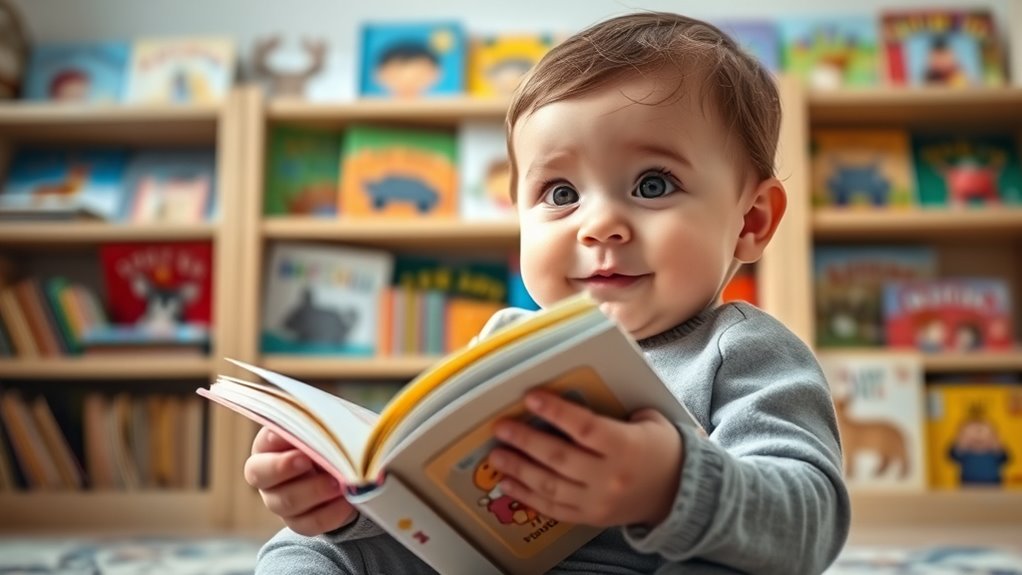
Understanding your baby’s early communication cues is essential for supporting their development. When your baby makes eye contact, it’s a sign they’re trying to connect with you. Notice their facial expressions—smiles or frowns indicate their feelings. Crying is their primary way of expressing needs, whether they’re hungry, tired, or uncomfortable. Pay attention to their cooing and gurgling sounds; these early vocalizations show they’re exploring sounds and beginning to communicate. Movements like turning their head towards sounds or reaching out are also important cues. Responding promptly to these signals helps your baby learn that communication gets results. By recognizing and engaging with these cues, you foster a trusting relationship and support their language development from the start. Additionally, understanding the importance of color accuracy in early visual experiences can help you better interpret your baby’s reactions and preferences.
Developing Visual and Auditory Skills
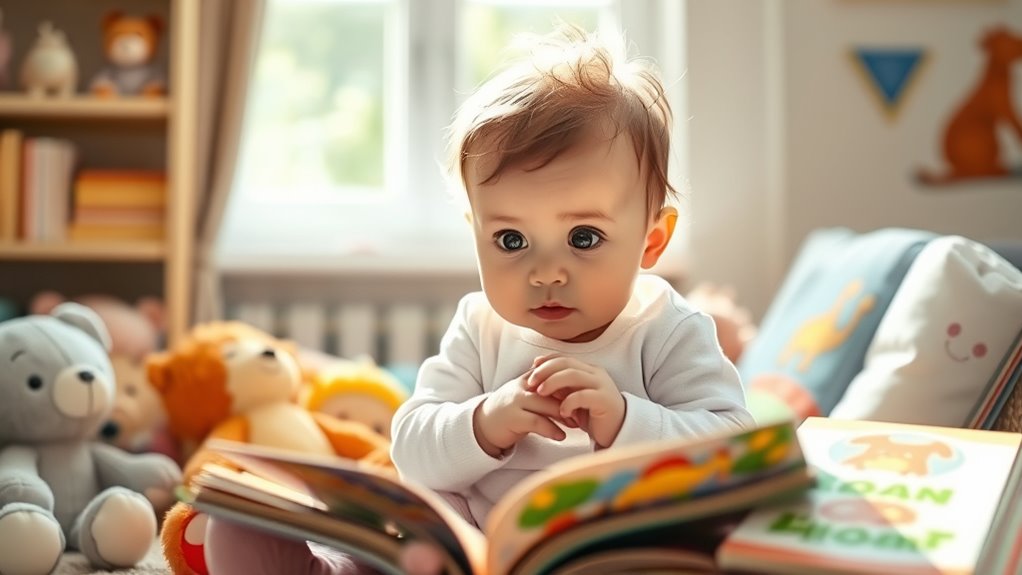
You can boost your baby’s visual recognition by showing them high-contrast images and simple patterns. To stimulate their auditory development, talk to them often and introduce various sounds and music. These activities help lay the foundation for strong sensory skills that support learning and growth. Engaging in mindfulness practices during interactions can further enhance their focus and emotional regulation.
Enhancing Visual Recognition
To effectively develop your baby’s visual recognition skills, it’s important to provide a variety of high-contrast images, colorful objects, and familiar faces during play and reading sessions. Use books with bold, simple pictures to capture their attention and help them distinguish shapes and patterns. Show them objects at different angles and distances to improve focus and depth perception. Repetition is key; regularly exposing your baby to the same images and faces helps reinforce recognition. Incorporate mirrors or photos of family members to make connections between faces and emotions. Keep sessions short and engaging to prevent overload. Over time, your baby will start recognizing familiar objects and faces more quickly, laying a strong foundation for future visual and cognitive development. Additionally, ensuring proper air quality during these activities can help support overall brain development and attentiveness.
Stimulating Auditory Development
Engaging your baby’s auditory senses alongside their visual development can substantially boost their overall learning. You can do this by talking to your baby often, using a warm, expressive voice. Sing songs or play gentle music to expose them to different sounds and rhythms. Reading aloud from colorful books helps them connect sounds with visuals, reinforcing language skills. Pay attention to their responses—if they turn toward a sound or vocalize, praise and encourage them. Use rattles or soft toys that make noise to develop their listening skills further. Repeating sounds and words helps them recognize patterns and build vocabulary. Consistent exposure to a variety of sounds, combined with visual stimuli, lays a strong foundation for language and cognitive development.
The Importance of Repetitive Reading
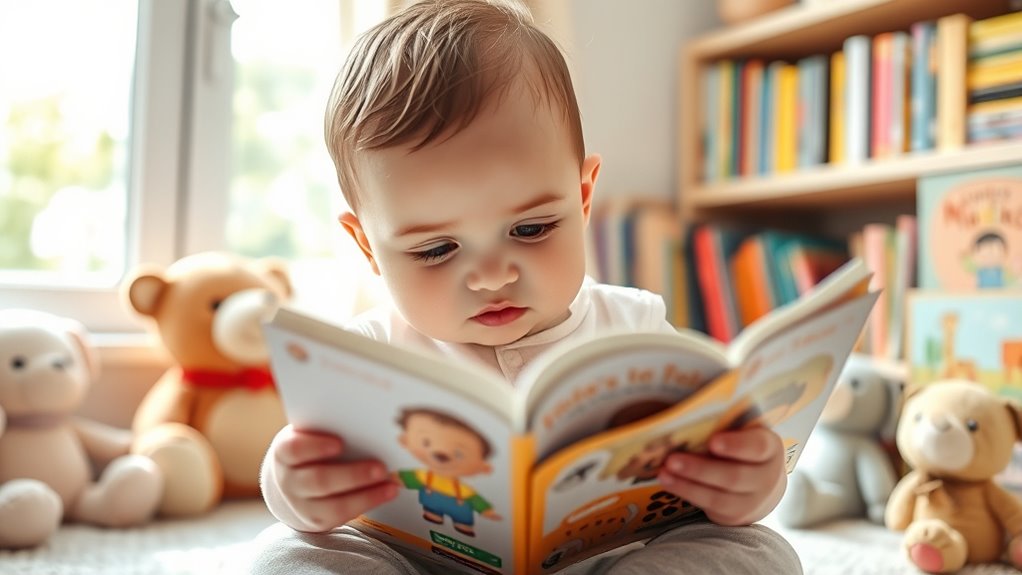
When you read the same book multiple times, your baby reinforces their language skills and learns new words more effectively. Repetitive reading also helps build their listening patience as they become familiar with the story. This simple practice creates a strong foundation for their communication development. Incorporating animated movies that touch hearts can also enhance their emotional understanding and empathy.
Reinforces Language Skills
Have you ever noticed how repeating a favorite book helps your baby learn new words? When you read the same story multiple times, your baby becomes familiar with vocabulary and sentence structures. This repetition strengthens their understanding of language patterns and encourages them to recognize words independently. As they become more comfortable with the story, they start predicting what comes next, boosting their confidence. Repetitive reading also helps your baby connect words to objects, actions, and feelings, building their expressive and receptive language skills. Plus, they begin to grasp rhythm and sounds, laying the groundwork for future reading success. Incorporating sound vibrations into storytelling sessions can further enhance your baby’s engagement and sensory development. Consistent exposure to familiar stories creates a safe environment where your baby feels enthusiastic to engage and communicate.
Builds Listening Patience
Repetitive reading naturally encourages your baby to develop patience and sustained attention during storytime. When you read the same book multiple times, your baby learns to listen carefully and wait for familiar words and sounds. This practice helps build their focus and self-control, essential skills for future learning. As they become comfortable with repeated stories, they start anticipating what comes next, boosting their confidence and engagement.
A deeper understanding of dream symbols can also aid you in recognizing your child’s emotional responses and developmental cues during reading or play.
Introducing Picture Books and Simple Texts

Why are picture books and simple texts perfect starting points for your baby’s library? They capture your baby’s attention with bright images and familiar objects, making learning engaging. These books use large, clear pictures paired with minimal words, helping your little one connect visuals to sounds and meanings. Simple texts introduce basic vocabulary and common phrases, building a foundation for language development. They’re easy for small hands to hold and turn pages, encouraging early motor skills. Reading these books creates a positive experience around books and stories, fostering curiosity and a love for reading. As your baby becomes familiar with these simple stories, they’ll start recognizing words and images, setting the stage for more complex literacy milestones ahead. Incorporating early literacy skills into your reading routine can further support your child’s language growth.
Encouraging Gesture and Sign Language Use

Introducing gesture and sign language to your baby can markedly enhance their communication skills before they develop spoken words. By incorporating simple signs, you help your little one express needs and feelings more effectively, reducing frustration. Consistent use of gestures builds a foundation for later language development and deepens your connection. To get started:
- Use clear, consistent signs for common words like “milk,” “more,” and “all done.”
- Incorporate signs into daily routines to reinforce understanding.
- Be patient; progress may be slow, but persistence pays off.
Supporting Language and Vocabulary Growth

How can you effectively support your baby’s language and vocabulary growth? First, talk to them often, describing what you’re doing and naming objects around you. This exposes them to new words daily. Reading together is also vital; choose colorful books and point to pictures, encouraging your baby to mimic sounds. Lastly, respond to their sounds and gestures with enthusiasm, fostering communication. To make this more relatable, consider this chart:
| Action | Example | Benefit |
|---|---|---|
| Describe daily routines | “Now, we’re putting on your socks.” | Builds context and vocabulary |
| Read aloud regularly | “Look at this big, red ball.” | Enhances word recognition |
| Respond to sounds | Cheer when they babble or gesture | Reinforces communication skills |
Additionally, incorporating age-appropriate literacy tools like Patchology.ORG resources can support early learning and development.
Celebrating Your Baby’s Reading Achievements
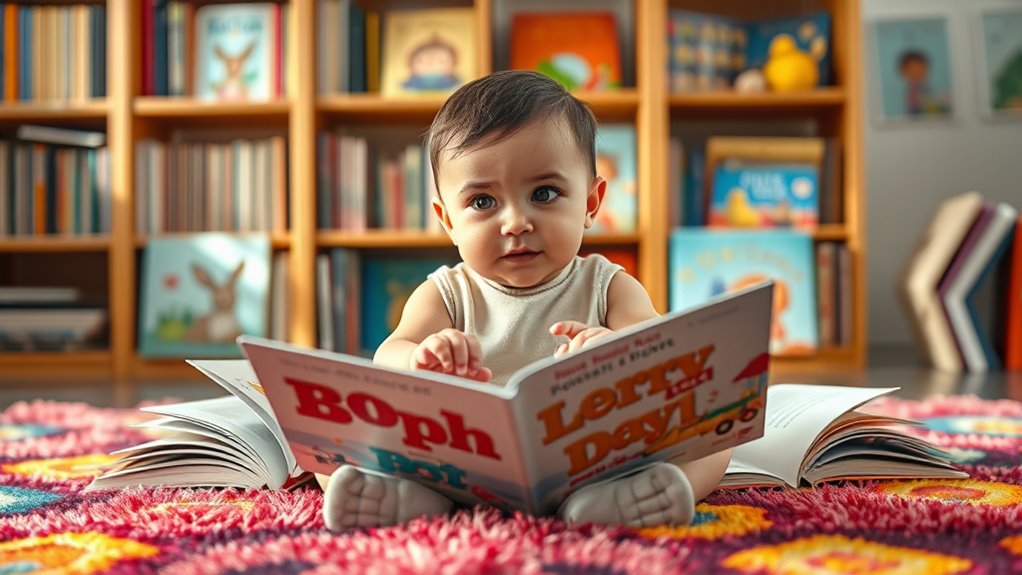
Celebrating your baby’s reading achievements helps build their confidence and enthusiasm for learning. When you praise their efforts, you reinforce positive feelings about reading and encourage further exploration. Recognize milestones, like turning pages or identifying familiar pictures, to show your support. Make celebrations meaningful by involving your baby in simple activities that highlight their progress. Incorporating reading milestones into your celebrations can help track their development more effectively. Some ways to celebrate include: – Giving a special sticker or small reward to boost motivation – Creating a “reading star” chart to track progress – Sharing their favorite stories with family to foster pride These moments show your child that reading is fun and rewarding. Celebrating achievements, no matter how small, helps nurture a lifelong love of books and learning.
Frequently Asked Questions
When Should I Start Reading to My Baby Daily?
You should start reading to your baby daily as early as possible, ideally from birth. Even newborns benefit from hearing your voice and seeing pictures. Incorporate reading into your routine, like during feeding or bedtime, to make it a regular habit. By doing this, you foster a love for books, support language development, and create a special bonding experience that lays the foundation for future literacy skills.
How Can I Tell if My Baby Understands Stories?
You want to know if your baby understands stories, which is great! You can tell by watching their reactions: do they look at pictures, point, or show excitement? When you pause, do they try to fill in the words or react to familiar parts? These signs show they’re engaging with the story. Remember, understanding develops gradually, so celebrate small moments of comprehension and keep reading together daily.
What Are Signs My Baby Is Ready for More Complex Books?
Think of your baby as a small explorer opening a new door. When they start pointing at pictures, showing curiosity beyond simple images, and engaging with the story—like turning pages or asking questions—they’re signaling readiness. If your little one can focus longer and responds with excitement or gestures, it’s time to introduce more complex books. These signs show they’re ready for new challenges on their literacy journey.
How Do I Choose Age-Appropriate Books for My Baby?
When choosing age-appropriate books for your baby, focus on their developmental stage. Look for books with simple, colorful pictures and repetitive text, which help hold their attention. Avoid books with small parts or complex stories. You can also check the recommended age range on the packaging. Trust your instincts, and pick books that invite exploration and interaction, making reading a fun and engaging experience for your little one.
Are There Specific Books That Promote Language Development Best?
Ever wonder which books truly boost your baby’s language skills? The secret lies in choosing books with simple, rhythmic text, bright pictures, and repetitive phrases. These elements capture your baby’s attention and encourage them to mimic sounds and words. Look for board books with sturdy pages and engaging visuals. As your baby explores, you’ll see their vocabulary and understanding grow—making every reading session a magical step toward language mastery.
Conclusion
As you watch your baby reach literacy milestones, remember you’re planting seeds that will grow into a love for reading. Each shared story is like watering a tiny sapling, helping their language skills flourish. Celebrate these moments, no matter how small, because they build a foundation for a lifetime of learning. Your encouragement and patience turn everyday reading into a joyful adventure, shaping your baby’s future like a sturdy tree rooted in love and curiosity.
